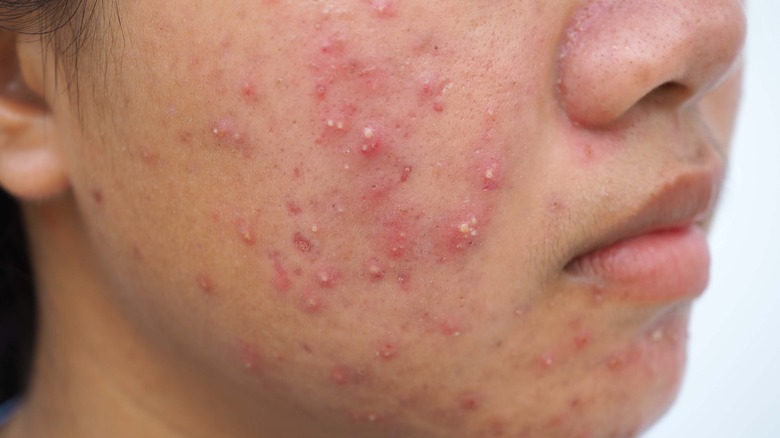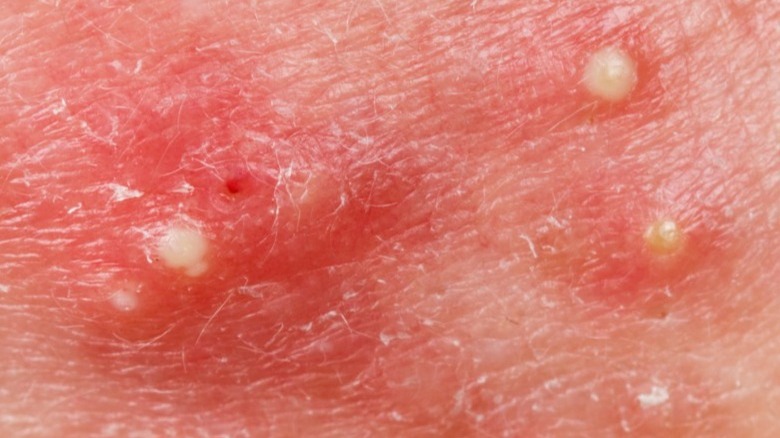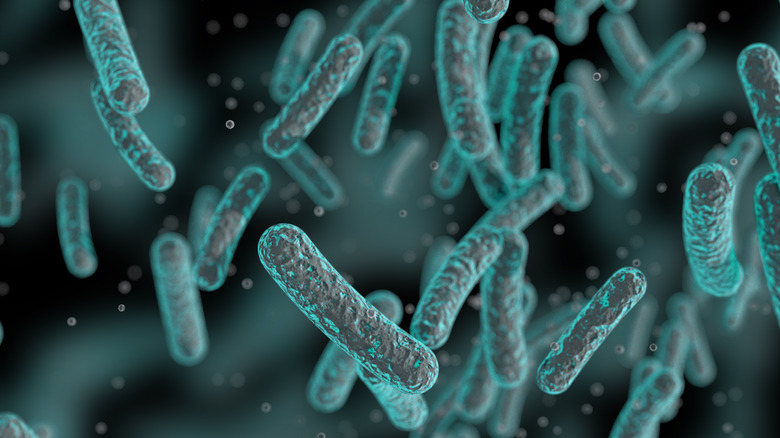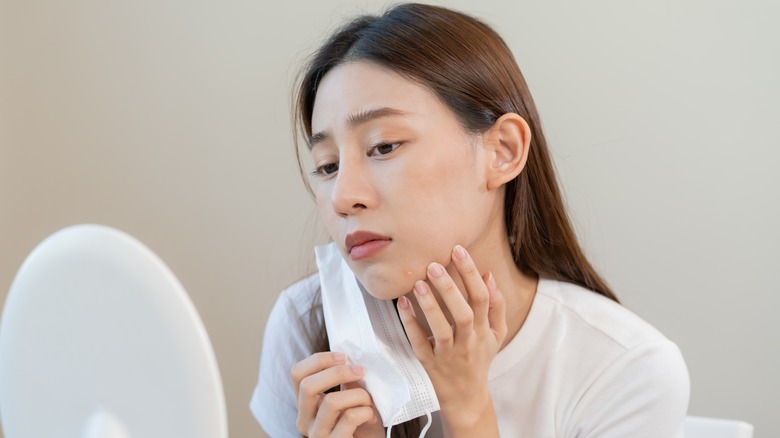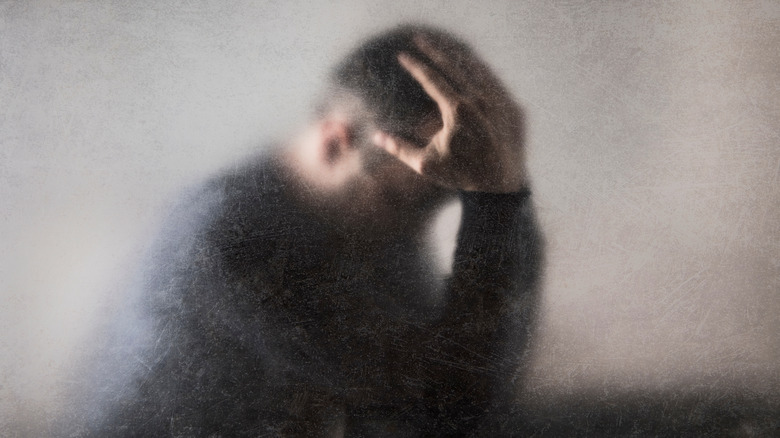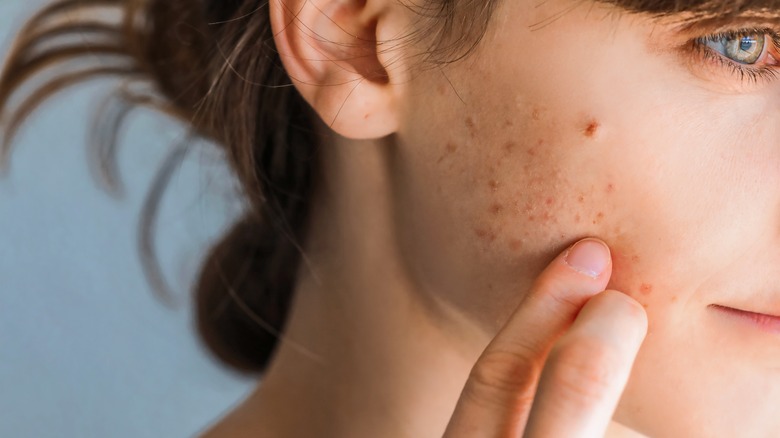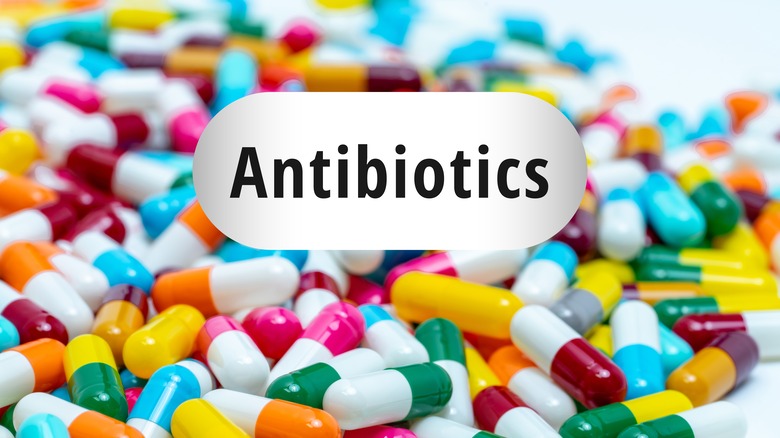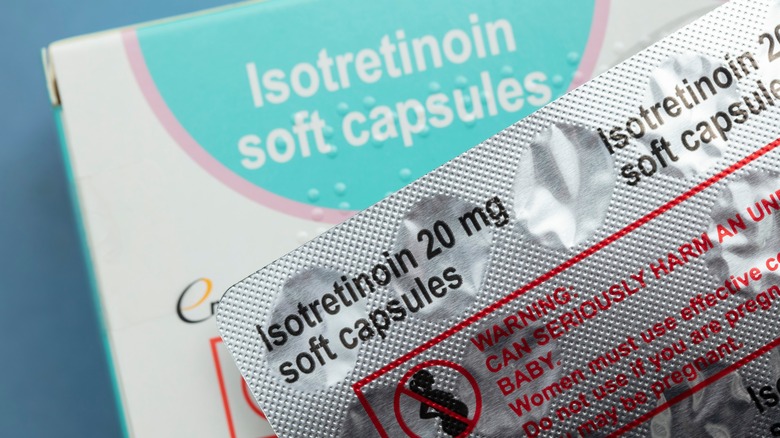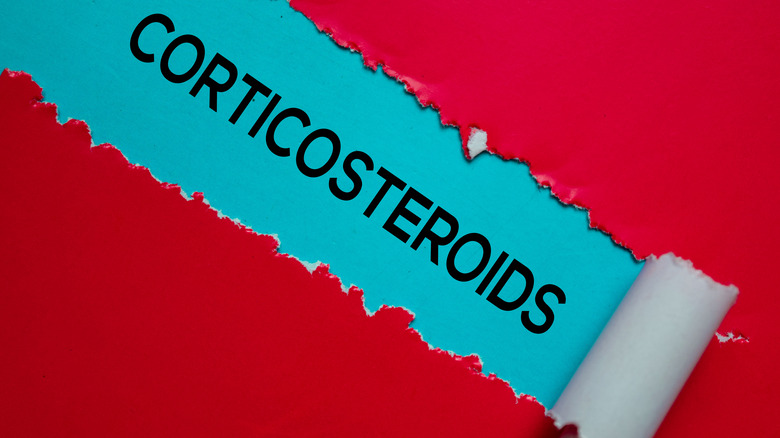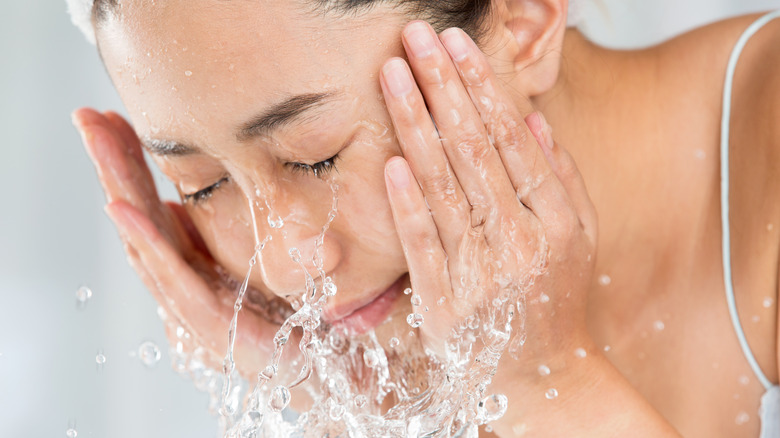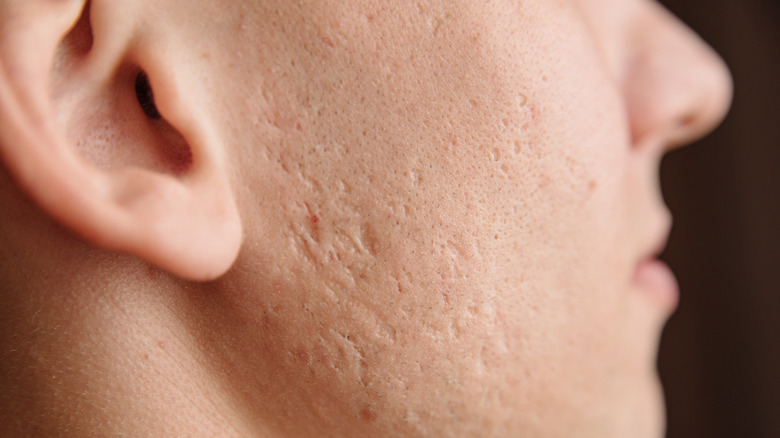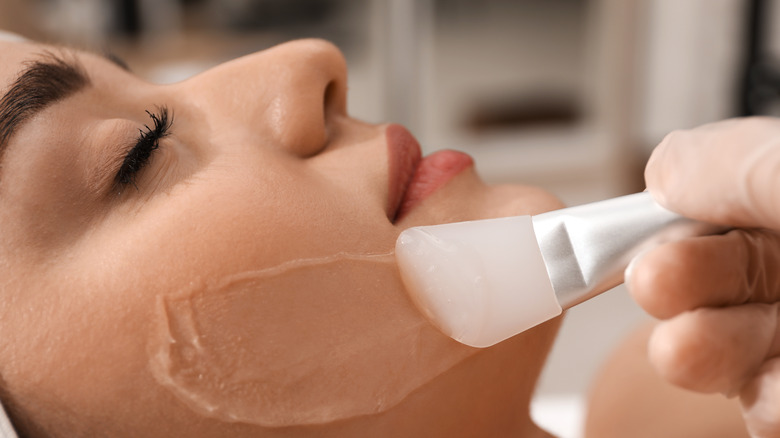Cystic Acne Explained: Causes, Symptoms, And Treatments
Almost no one makes it through adolescence without dealing with acne — though some have it worse than others. Even adults who think their pimple-popping days are over break out from time to time. Dealing with acne can be distressing, especially if you have a big date or job interview coming up. But acne can be more than just an annoyance. For some, it is a medical condition. Cystic acne is a serious form of acne that is much worse than a bad pimple before an important event.
According to the Mayo Clinic, cystic acne is "the most severe form of acne." Cystic acne develops deep within hair follicles where dead skin cells and oil can sometimes build up. The resulting pimple causes more severe inflammation than a regular pimple and can even resemble a boil. Fortunately, there are many treatment options available for even severe skin conditions like cystic acne. The American Academy of Dermatology Association states that proper treatment from a dermatologist can clear up almost any case of acne.
Cystic acne explained
Cystic acne is a type of severe acne that goes beyond a few pimples here and there. Per the American Academy of Dermatology Association, people with cystic acne develop cysts and nodules deep in the layers of the skin. Both are painful bumps that appear red and inflamed — but cysts are filled with pus while nodules are harder and solid (via the Cleveland Clinic). People with cystic acne may also develop whiteheads and blackheads in addition to their acne cysts.
People with cystic acne feel its impact on their appearance both now and in the future. The telltale cysts appear red and swollen during breakouts but according to the Cleveland Clinic, they also lead to scarring, which is an unpleasant reminder of acne that can last for years. According to one study, scars can negatively affect people's body confidence and self-image. People with scars are prone to develop depression and anxiety and to experience "feelings of shame and aggression."
Causes of cystic acne
Cystic acne is a type of bacterial skin infection. A 2016 study published in the Zanco Journal of Medical Science sampled pus from 160 patients suffering from acne. The researchers then identified the bacterium Propionibacterium acnes as the pathogenic, or disease-causing, bacterial species that causes acne. According to the Cleveland Clinic, cystic acne starts when bacteria, dry skin cells, and oil become trapped deep in the pores of the skin.
It's no surprise that teenagers, with their rapidly changing hormone levels, are prone to developing cystic acne. However, adults can also develop cystic acne. Women going through menopause and people facing a lot of stress may also experience the hormonal fluctuations that lead to cystic acne. Having a strong family history of cystic acne also puts people at risk of developing this condition. Although you may be able to manage your stress level, there is nothing you can do to manage risk factors such as your age or hormonal fluctuations.
How to distinguish cystic acne from regular acne
If you currently suffer from acne, you might wonder whether you have run-of-the-mill acne or cystic acne. It is an important distinction to make because knowing which condition you have can help you make an informed decision about your treatment options.
According to Johns Hopkins Medicine, acne is a broad term that describes inflammation and pimples that develop in clogged hair follicles. When these follicles become plugged with dead skin cells and oil, P. acnes bacteria begin to grow, leading to pimples. Several types of pimples can form, including whiteheads, blackheads, pustules, papules, nodules, and cysts. Regular acne includes the various pimples that form on the skin's surface, whereas cystic acne includes just the nodules and cysts that form in the deep layers of the skin (per Healthline).
The larger pimples that characterize cystic acne are red, inflamed, and have a pus-filled white bump. They are also tender and painful.
Cystic acne is more than just bad skin
Cystic acne does not affect just the skin. It can affect a person's social life, self-image, mental health, and more. According to the Cleveland Clinic, people with cystic acne may feel self-conscious or embarrassed about their appearance and may start to think of themselves as unattractive. The resulting low self-esteem and negative self-image prevents some people, especially teens, from making friends. Some get bullied. People with cystic acne may feel alone and have an overall decreased quality of life.
Over time, the effects of cystic acne can lead sufferers to develop clinical mental health conditions. A 2020 study from the Journal of the American Academy of Dermatology found that cystic acne was associated with depression and anxiety. A 2021 study in the journal Medicine found that acne may significantly increase an individual's risk of suicide. These findings highlight the severe emotional impact that cystic acne can have on a person's life.
Avoid treating cystic acne on your own
If you are currently experiencing an acne outbreak, cystic or not, of course you want to do something about. Magazines are filled with at-home acne remedies, drugstores sell a variety of over-the-counter acne treatments, and the internet is chock-full of how-to videos for dealing with problem skin. In general, however, cystic acne does not respond well to at-home treatments. In fact, home remedies for cystic acne can cause scarring or pigmentation problems, particularly in people with skin of color. Skin with more melanin is more likely to become hyperpigmented or discolored with at-home treatments. Attempting to drain an acne cyst by picking or popping it can spread the inflammation to other parts of your face, aggravating your skin (via the Cleveland Clinic).
The best way to treat cystic acne is by seeking medical advice from a dermatologist, but you may not be able to get an appointment right away. If you have an acne cyst that is especially painful, you can ice it to get some relief (per Healthline). Wash your face with a gentle cleanser first, then ice the affected area for one minute at a time, with five minutes in between applications. Wrap the ice in a cloth or paper towel to avoid direct contact between the ice and your skin. Treatment with ice should reduce the pain and swelling.
A dermatologist can remove acne cysts
Your dermatologist can physically remove an acne cyst or nodule, which may be a good option if you have one or more cysts or nodules that are especially painful or inflamed. According to the American Academy of Dermatology Association, doctors have a few options when it comes to manual removal of acne cysts.
One option is to inject a corticosteroid directly into the cyst or nodule. Corticosteroids have strong anti-inflammatory properties (per the Mayo Clinic), so this injection should quickly reduce the swelling and pain caused by the nodule or cyst.
Another option is to drain it with either an incision by a needle or scalpel (via the Merck Manual). Your doctor will clean the skin first, then apply an anesthetic so that you do not feel the incision. Then, the doctor will pierce the cyst or nodule with a needle or lance it with a scalpel. With a needle incision, the doctor can drain the pus with the syringe. With a scalpel incision, the doctor will gently squeeze the pus out. Both procedures open the cyst, which can lead to infection, so you should never attempt to drain an acne cyst on your own.
Antibiotic treatments for cystic acne
A dermatologist can recommend the best treatment plan for your individual case of cystic acne. Because a bacterial infection causes acne cysts, antibiotics are one treatment option. Many dermatologists choose antibiotics as the first step in treating cystic acne. According to a 2016 study, doctors may prescribe topical antibiotics, often in combination with benzoyl peroxide, or oral antibiotics (via the Journal of the American Board of Family Medicine).
You can get benzoyl peroxide over the counter or with a prescription. It treats cystic acne by killing microbes like P. acnes, reducing inflammation, and treating existing comedones (aka whiteheads) while preventing new ones from forming. Benzoyl peroxide also enhances the efficacy of antibiotic treatment.
Your doctor may prescribe topical antibiotics such as clindamycin and erythromycin or oral antibiotics such as doxycycline, minocycline, azithromycin, cephalexin, and trimethoprim-sulfamethoxazole. Because bacteria can become resistant to antibiotics with time, antibiotic treatment for cystic acne is a short-term option and should not be used to maintain clear skin.
Prescription treatments can help with cystic acne
Antibiotic treatments sometimes fail to work or only work for a short time (per the American Academy of Dermatology Association). When this happens, dermatologists may recommend other prescription treatments such as isotretinoin, an oral medication, or topical retinoids.
Isotretinoin is an extremely effective oral acne treatment. According to a 2020 review published in the Cochrane Database of Systematic Reviews, 85% of patients become clear of acne after 16 weeks of treatment. Isotretinoin reduces the size of the sebaceous glands as well as the rate of sebum production, which changes the environment P. acnes needs to grow and thrive. Decreasing the population size of this bacteria dramatically improves cystic acne.
Although it is an extremely effective treatment, isotretinoin does cause side effects; some of them serious. The most common side effects are inflamed lips, dry skin, facial dermatitis (a red rash around the mouth), discoid dermatitis (a coin-shaped rash on the skin), and blepharoconjunctivitis (inflammation of the eyelids and the conjunctiva, the thin layer that covers the eyelids and the whites of the eyes). Regular application of lip balm, eye lubricants, and moisturizers should resolve these side effects. More alarming is the fact that isotretinoin causes birth defects and spontaneous abortions, so women who are pregnant or might become pregnant should never use it.
Topical retinoids such as Retin-A are another good choice for treating cystic acne, according to a 2022 study published in the Journal of Cutaneous Medicine and Surgery. Doctors may prescribe retinoids along with benzoyl peroxide or antibiotics.
Some treatments are available for women only
While anyone can use cystic acne treatments such as antibiotics, isotretinoin, and retinoids, others are available only to women. One treatment only females can use is spironolactone. It works by blocking the effects of androgens (male hormones) on oil glands (per Johns Hopkins Medicine). Spironolactone can cause minor side effects such as painful periods and tender breasts. According to a 2021 study in the journal Dermatology and Therapy, it is a good alternative to antibiotics and can help prevent antibiotic resistance.
Hormonal contraceptives are another acne treatment available to just women. A 2021 study published in the American Journal of Clinical Journal of Dermatology found that combined oral contraceptives and vaginal rings were an effective treatment for acne. Other birth control options, such as hormonal implants and hormonal IUDs, had the opposite effect, triggering or worsening acne. Talk to your doctor about the birth control option that works best for you if you have concerns about cystic acne or already have this condition.
Oral corticosteroids can improve cystic acne
Oral corticosteroids are another treatment option for people with cystic acne, according to 2015 review in the British Journal of Dermatology. Doctors may prescribe oral corticosteroids in conjunction with isotretinoin. Steroids can reduce the inflammation associated with cystic acne as well as any inflammation caused by the isotretinoin treatment. Treatment with isotretinoin plus the steroid prednisolone for four to six weeks improved severe acne in the patients studied.
Patients who use corticosteroids for more than three months may experience some adverse side effects such as hypertension, weight gain, and osteoporosis, according to a 2021 review by the National Institute for Health and Care Excellence. Negative side effects are always important to consider when choosing a medication, so talk to your doctor about the risks and benefits of steroid treatment for your cystic acne. A treatment plan of four to six weeks may improve your acne without putting you at risk of any side effects from the steroid treatment.
Skincare routines can keep cystic acne at bay
People with cystic acne respond best to treatment from a dermatologist, but a good skincare routine is critical to maintaining healthy skin and preventing a recurrence of cystic acne. While you might be tempted to wash your face several times a day, your best bet is to use a gentle cleanser just once a day, although you may also want to wash after working out to remove sweat and oils. When you wash, avoid harsh cleansers or rough scrubs. Strong cleansers and scrubs can irritate and inflame cystic acne (per Healthline).
If you wear makeup, choose oil-free and non-comedogenic makeup to avoid clogging your pores. Although you have probably heard this before, it is worth repeating: "Never go to bed with makeup on." Take a few minutes to remove your makeup at the end of the day. You should also wear sunscreen daily and be sure to choose oil-free sunscreen as well.
Cystic acne causes scarring
Acne cysts often leave scars behind. Cystic acne typically develops on the face but also on the back, chest, neck, and shoulders (per the Mayo Clinic). These parts of the body have the most oil glands with hair follicles connected to them, and cystic acne develops in hair follicles. Cystic acne can cause scarring in any of these locations.
People with cystic acne are prone to develop certain types of scars known as atrophic scars (per Healthline). Atrophic scars are flat, shallow depressions beneath the skin's top layer. There are three types of atrophic scars: boxcar scars, ice pick scars, and rolling scars. Boxcar scars are broad and box-shaped with strongly defined edges. Ice pick scars are smaller, narrow, and point down into the skin, hence the name — these scars commonly occur on the cheeks. Rolling scars have sloping edges that make the skin look uneven and wavy.
Scars from cystic acne are an unpleasant reminder that last long after the acne itself has cleared up. Thankfully, there are many treatments available to reduce and improve the appearance of scars.
How to prevent and treat acne scars
Anyone who has ever had acne, whether it was cystic acne or not, understands the urge to pop a pimple. Unfortunately, popping or picking at an acne cyst can spread the P. acnes bacteria, leading to further infection, and it can also lead to scarring (per Healthline). The best thing you can do for your skin is to leave it alone and follow the treatment plan recommended by your dermatologist.
But even people who follow their treatment regimen to a T may still develop acne scars. Fortunately, you have several options to reduce scarring once your cystic acne has healed. A dermatologist can perform a chemical peel, dermabrasion, or laser resurfacing to reduce acne scars. All three treatments remove the older cells from the upper layers of skin in the scars to reveal younger cells and give the skin a smoother appearance.
Chemical peels accomplish this with alpha-hydroxy, beta-hydroxy, and trichloroacetic acids or phenol (per Medical News Today). Dermabrasion uses a "rapidly rotating device" (per the Mayo Clinic), while laser resurfacing removes these layers with a laser (per the American Society for Dermatologic Surgery).
Fillers are another option to reduce the appearance of acne scars. According to the American Society for Dermatologic Surgery, injectable polymethylmethacrylate with bovine collagen, commercially known as Bellafill, is the only filler approved by the Federal Drug Administration (FDA) to treat acne scars. It's a good choice for patients who have depressed acne scars. This filler can last for up to five years.

